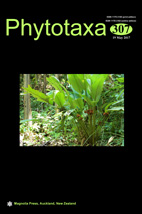Abstract
The genus Wilmottia was described based on polyphasic studies of Phormidium murrayi populations that revealed them not closely related to other Phormidium species, despite their morphological similarity. The genus contained one species, W. murrayi, found exclusively in cold and temperate areas of the world. Other species morphologically similar to Phormidium were expected to pertain to Wilmottia, but the genus remained unispecific until now. During a survey of Cyanobacteria in Brazil, 11 strains morphologically similar to Wilmottia from southern and southeastern regions were isolated in unicyanobacterial cultures and submitted to polyphasic evaluation (morphological, ecological and molecular studies). The populations studied presented homogeneous morphology (trichomes cylindrical, straight and not attenuated) and were found inhabiting quite diverse environments (freshwater, wet soil and barks of trees). The molecular analyses based on 16S rRNA gene sequences placed the 11 studied strains in two distinct clusters inside the highly supported Wilmottia clade. The 16S-23S ITS marker was very variable and did not provide consistent information to improve the differentiation among the strains. The characteristics of the Brazilian populations, essentially the genetic ones, resulted in the recognition of a new cryptic species of Wilmottia (W. stricta) and indicated a wider distribution for W. murrayi. Such distribution would comprehend a wide climatic range (from polar to tropical) and occurrence in very distinct habitats (aquatic and aerophytic). The possible explanations to that scenario would be the low sensitivity of 16S rRNA gene as marker for distinguishing species inside of this complex of strains or W. murrayi actually represents a case of ubiquitous species. The addition of other genes or whole genome sequencing could be the way to reach a more confident answer. Wilmottia reveals a very intricate phylogeny according to the 16S rRNA gene and more studies are recommended to confirm its monophyly.

